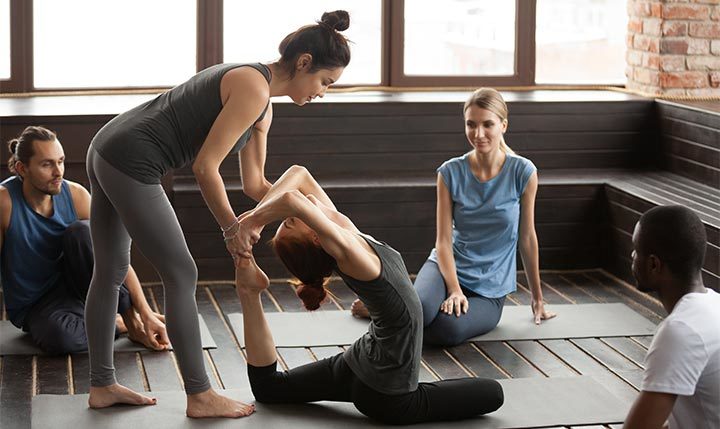
Yoga is a practice that connects the mind, body and soul. It entails the use of physical postures, breathing exercises, and meditation for the improvement of overall health. Yoga has a number of health benefits and is often turned to for relieving symptoms of stress and anxiety, and to improve overall health and posture. While millions of people have turned to yoga for a variety of reasons, it is a practice that can be introduced into one’s life, not just for physical benefits, but also for its share of meditative and spiritual benefits.
The practice of yoga has traditionally been seen as a path towards a heightened sense of consciousness and mindfulness, as it facilitates a profound awareness of how the mind, body and soul are linked and how every human being is connected to the energies of the universe.
In a world dominated by technology and procrastination, yoga is one of the very few spiritual practices that help an individual centre their thoughts and improve attention and focus. It is only during the practice of this serene art, that one can truly unplug from the distractions of the rest of the world and shift the focus to what truly matters. As the body enters a state of calm, the Ming will slowly and steadily begin to relax, too.
The Art of Teaching Yoga
 As yoga professionals, we have the honor and privilege to guide various individuals through a variety of processes to help them work towards not just their fitness goals, but also their lifestyle. It is a process that is always challenging but also always rewarding.
As yoga professionals, we have the honor and privilege to guide various individuals through a variety of processes to help them work towards not just their fitness goals, but also their lifestyle. It is a process that is always challenging but also always rewarding.
Being a yoga teacher is as good as a dream come true. We can take a pass time, a practice that we wholeheartedly love, and convert it into a full-blown career that supplements our income. As teachers, it is an honor to watch students develop the skill and polish it before finally mastering the practice.
Teaching Yoga Today
Taking up the job of a yoga instructor does not just mean entering a class, instructing a group of students and then leaving. It entails much more than the simple art of instruction. Becoming a yoga instructor requires an individual to be able to bring the practice to life. As often said and heard, the practice of yoga is not just an art but also a science. The key target of an instructor should not be limited to just weight loss and flexibility, it should also spark an inspiration in the students to pursue the practice with the lifelong passion to do better and be better, not just in the physical aspect, but also in all the other walks of life.
 While some teachers are more experienced than others, it is the overall energy of the trainer and how they guide individuals through the practice that eventually differentiates one instructor from the other. With an estimated 200 million people turning to Yoga worldwide, capable yoga teachers are being sought after way more now.
While some teachers are more experienced than others, it is the overall energy of the trainer and how they guide individuals through the practice that eventually differentiates one instructor from the other. With an estimated 200 million people turning to Yoga worldwide, capable yoga teachers are being sought after way more now.
Becoming a sought-after Yoga Teacher
For all those individuals who are working towards becoming the best version of themselves as teachers, there are a few qualities that distinguish exceptional trainers from the rest of the lot aspiring to be Yoga professionals.
Knowledge
Like any other field, Yoga requires a core understanding of the practice-the Asanas, the Mudras, and their benefits.
Leadership qualities
Like any other profession, Yoga requires individuals with strong leadership qualities who can confidently guide an entire room of yogis towards flexibility discipline and alignment, not just during the practice but also in daily life.
Alignment
While practicing yoga, alignment is an essential key to help the mind, body and soul work in harmony. Perfecting the poses to ensure safe and efficient positioning is an important part of the practice.
Sequencing
The term sequencing refers to the skill of putting together a harmonious and well aligned sequence of yoga postures for maximum benefits.
The Philosophy of Yoga
The main philosophy of yoga revolves around the mind, body and soul that should function in alignment with one another. Yoga helps delve deeper into the dimensions of the mind, body and soul. In order to become a capable yoga trainer, it is essential that an individual dive deeper into understanding the true capability and value of the body.
Anatomy
A trainer must understand the human body and how it benefits from various asanas, mudras and meditation practices. They must be capable of deciding the various asanas that work better for an individual depending on the body, flexibility, and major or minor problems such as back pain, knee pain, migraines, or even other health issues if any. While working towards becoming a certified yoga trainer, one must make sure they have an eye for the right and wrong poses, possess good correction skills and the ability to communicate them effectively to the students in order to avoid any form of injuries and misinformation.
Setting the Ambiance of the Class
Students respond better and are more attentive when they set foot in a studio where the ambiance is relaxing. The surroundings, the music, the conditioning exercises, the feel of spirituality play an equally important role in building the mood and preparing the mind and body for the spiritual practice. While some yoga trainers focus more on the aspect of fitness, others focus on spiritual awakening. During any yoga class, introducing a sense of dedication and motivation at the beginning of the class and reviewing the class towards the end will help improve the student-teacher bonding and will also make the students feel more involved on a personal level.
A few ideas to help make students feel more at-home during a class are:
• Making slight adjustments in the class to help students feel taken care of.
• As a trainer, one must keep in mind not to draw too much attention to beginners as they are already awkward and uncomfortable during the first few classes.
• While instructing the class, trainers must try to help students familiarize themselves with not just the Sanskrit names of the asanas, but also the English names along with the benefits of each asana, so the students are more aware of why they are doing what they are doing and how it will benefit them in the long run. This helps students develop a more personalized relationship with the practice.
• Yoga comprises of many different forms. These include: Hatha Yoga, Vinyasa yoga, Ashtanga yoga, Bikram yoga, and Iyengar yoga, to name a few. While trainers often stick to a certain form of yoga, they must make sure to mix it up once in a while to keep the monotony and boredom at bay.

Yoga is a personal journey that helps each individual approach their thoughts and improve their relationship with their bodies. The practice works differently for different people but will never once affect an individual in a negative manner. The practice has only benefits to offer. However, the capability of the yoga teacher will eventually decide the number of students who will stick by them.
As a teacher, what matters most is the love and passion for the practice, that will eventually reflect as and when the students benefit. The knowledge, authenticity and hardwork offered by a trainer makes students more receptive towards them. One of the key elements of practicing yoga is to be able to feel and receive the positivity, calmness, and peace that the practice brings. People will eventually respond to your style and mode of instruction. What you, as a teacher say and do will be taken into high regard, so as a trainer it is essential to set the right example, not set the bar too high, keep reminding individuals that aside from flexibility and fitness, peace and harmony are goals too. After all, Yoga is not just about the body. It is also about the body’s alignment with the mind and soul 🙂
Do not miss a single article!
Submit your email id to get new articles directly into your email inbox!
- Employee Wellness Programs: They Really Work! - October 21, 2022
- Yoga Teacher Training Standards - November 18, 2021
- Why You Will Never Go Hungry Again - October 25, 2021



